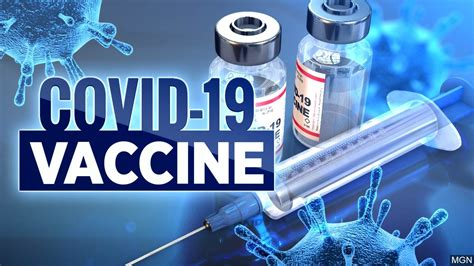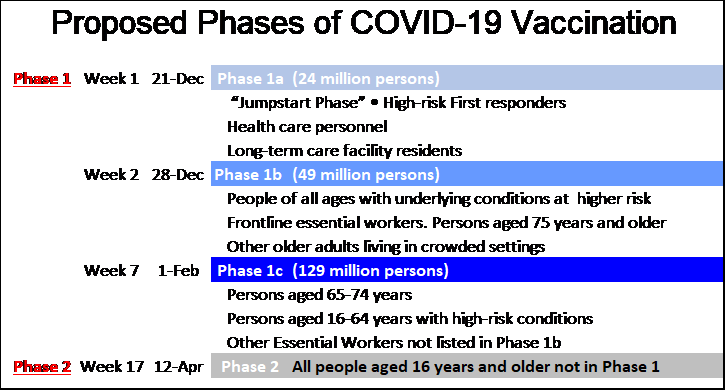
“Happy New year” shouted the CEO of a middle market manufacturing company on his year-end Zoom call to employees. And for a moment there was pure joy, then a silence, followed by a collective gulp.
No doubt history will record the many haunting echoes of a 2020 Auld Lang Syne like few before. But before the final chapter of the year of the pandemic is keyed into digital stone, we still have to get through the first half of 2021.
The good news is that not one but two Covid-19 vaccines have the green light and are already being manufactured and distributed to critical first responders and healthcare providers across the country. And that’s great news. Light at the end of the tunnel. But what about your company, your workers, your family… who may not be “essential workers” or frontline first responders? When can they get vaccinated?
First at hand in the new year now that Congress has passed a new supplemental $900 Billion-dollar Covid economic stimulus package is how to get back to normal as soon as possible. And hence the importance of getting immunized from shop floor to executive suite cannot be underestimated. Covid-19 has killed more than 340,000 people in the U.S. and temporarily shut down several manufacturing facilities across the country costing millions in losses. But even as Covid cases rise, so has the vaccine cavalry at last been mobilized and en route to save us.
Meanwhile, you may be surprised to learn that all the while a Covid-19 vaccine was being developed so was a Covid-19 vaccine roll-out recommendation plan created by the Center for Disease Control, the CDC. The plan is called the Phased Allocation of Covid-19 Vaccines. This is a risk-based assessment timeline based upon its virus tracking research that lays out a two-phase priority schedule for states to help identify, categorize, prioritize and immunize citizens and workers. This is essentially a federal recommendation to identify who gets the jab first.
At the moment there are only two approved vaccine suppliers in the USA, Pfizer and Moderna both are purportedly already distributing an estimated 70 million doses (35 million vaccinations) since late-December 2020, and both say each can make another 1 billion doses before the end of 2021. Moreover, there are still several additional corona virus vaccine candidates in various stages of development, the point being made to the public not to worry, there will be enough to go around, eventually. But you’ll also have to get in line according to CDC guidelines, and that’s causing some concerns.
It starts with leveraging the credibility of the Center for Disease Control at this stage to prioritize the population despite its heroic efforts to lead, and on day one be a fundamental resource and contributor to President Trump’s Operation Warp Speed, which helped create a Covid-19 vaccine in a record time. A real life-saving victory. But the real challenge remains in how best to immunize the country. And to that end the CDC developed its two-phase plan, which is really a 4-phase plan as you can see.
Here’s the suggested vaccine rollout plan:

The fundamental idea behind the CDC efforts to categorize people into vaccine priority groups is driven by Covid-19 death and exposure rate research in each group. For example, in phase 1 of the plan, first-responders and front-line workers in healthcare and those living at adult facilities will be vaccinated first, if state governments follow CDC guidelines. There are approximately 24 million people in this first phase, each require 2-doses which is about equal to the number of currently available doses and each are being vaccinated as you read this and watch on tv news. But who goes next is the problem.
The overall plan is expected to have started in late December 2020 and to continue for at least 6 months through June 2021 (25 weeks as shown in the diagram below). Each phase will overlap until we reach “herd immunity” roughly 60-70% of the U.S. population (200+ million vaccinations) in less than 6 months. A tall order for any administration. But where does this leave you?
To start, it might be a good idea to take a closer look at the updated CDC rollout plan and locate which phase your company workers will likely fall into. From there count the weeks from Christmas and you can roughly plan when your staff will qualify for that much needed shot in the arm. Who gets to be vaccinated first across different but connected industry groups could prove a sticky issue and jockeying for pole position has already started.
For example, in the FOOD INDUSTRY speaking up has already made a big difference in timing. According to the Food Institute analysis of the CDC plan “Workers in the food and agriculture, grocery store, and manufacturing industries have been designated as frontline ‘essential workers’ set to be vaccinated in Phase 1b,” weeks ahead of other industries.
My advice is to get ahead of this. If you can make the argument to your city Mayor or state Representatives that your workers are at a higher risk of contracting or spreading Covid and should be vaccinated asap, now is the time to make those calls. They are the ones mostly in charge of making the rules and need your input.
And lastly don’t forget. Tell them that however they prioritize vaccine immunizations it needs to be completely transparent, and fair. And maybe then with luck and God’s help history will record 2021 the year Covid died, and the whole world got back on its feet.

About the author: Rick Andrade is an investment banker at Janas Associates in Pasadena, Ca, where he helps CEOs and business owners buy, sell, and finance middle-market companies. Rick earned his BA and MBA from UCLA, along with his Series 7, 63, & 79 FINRA securities licenses. He is also a CA Real Estate Broker, a volunteer SBA/SCORE instructor, and blogs at www.RickAndrade.com on issues important to business owners. He can be reached at RJA@JanasCorp.com. Please note this article is for informational purposes only and should not be considered in any way an offer to buy or sell a security. Securities are offered through JCC Capital Markets LLC, Mem
